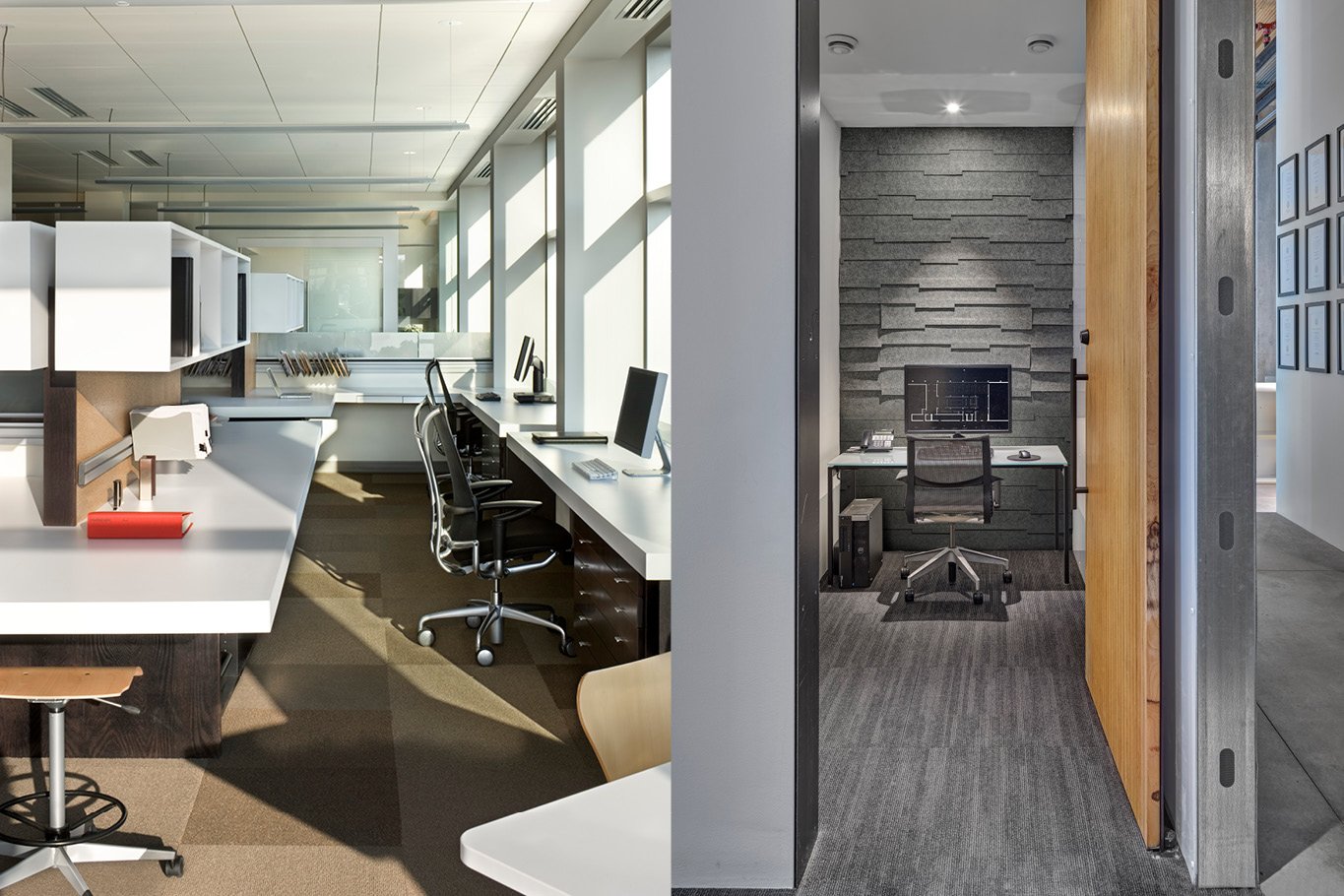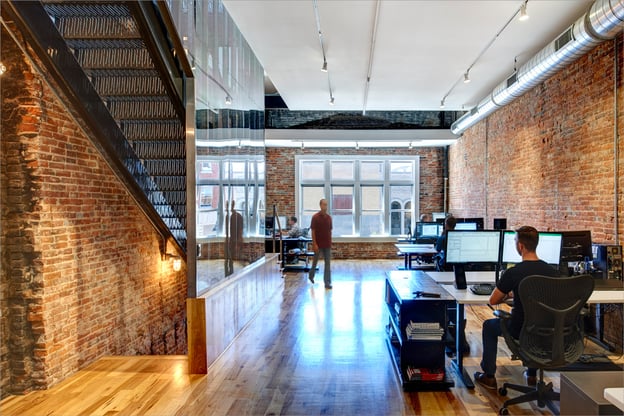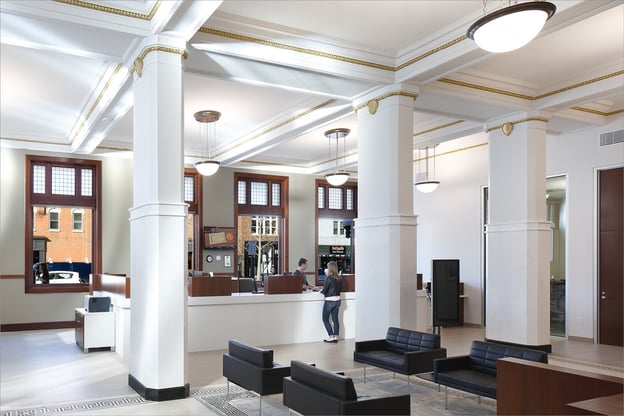Furniture vs. Casework in the Workplace: Which is Right for You?

A building project involves many macro and micro decisions. One of the decisions you will make is whether to outfit your space with furniture or casework.
Furniture refers to moveable items made by a manufacturer, while casework refers to modular components installed on site. Most building projects involve a combination of the two. For example, you may have casework cabinets and purchase seating from a furniture vendor.
Although your building may include both casework and furniture, you will need to make decisions about specific items. Should you have built-in shelving or purchase a moveable unit? Should you have moveable workstations or build them into the space?
The right decision comes down to your goals and budget. This article will discuss the advantages of each option, helping you determine which best fits your project.
What is Furniture?
On a building project, furniture is grouped into the larger category of Furniture, Fixtures, and Equipment (FF&E). FF&E can include anything from sofas to computers to artwork. Hypothetically, if you were to turn the building upside down, FF&E is everything that would fall out.
On most projects, FF&E is outside the construction budget. Your design team can help you determine your needs and connect you with local FF&E vendors who will help procure items. Your design team can also lead you through the process and write specifications before contacting a vendor.
Generally, these services are outside the scope of basic architectural services. Whether your design team or the furniture vendor leads the process, you will likely pay an additional professional service fee.
Furniture’s Advantages over Casework
Furniture often has a higher initial cost than casework but offers many benefits.
1. Flexibility
Furniture is inherently more flexible than casework. It is not attached to the building, making it easy to reconfigure your space.
When designing an office, furniture is often the most practical choice. Moveable workstations allow you to rearrange the space if your team grows or your needs change. Investing in furniture decreases the likelihood of extensive renovations, making it a cost-effective and sustainable option.
 Moveable workstations provide a greater amount of flexibility.
Moveable workstations provide a greater amount of flexibility.
2. Tax Depreciable
Private organizations can also claim furniture on taxes and depreciate the value over time. The current tax code specifies that businesses can depreciate the cost of furniture over seven years, allowing you to recover your initial investment.
Casework, on the other hand, is a part of the building and depreciates at a slower rate.
Depreciation does not apply to non-for-profits and public institutions. However, these organizations may receive special contracts from furniture vendors, resulting in a discounted price for bulk orders.
3. Warranties
Furniture often has a longer warranty than casework, and when you work with a vendor, replacing items is simple.
Many furniture manufacturers include barcodes that allow you to order replacement parts. If a desk drawer breaks, simply scan the barcode to get a new one shipped to your location.
Furniture manufacturers also keep up with changing work strategies and innovate new products, allowing you to order new items if your needs change.
Replacing casework may be more difficult. Casework is often customized to your unique specifications, so you forego the convenience of standardization. If easy maintenance and replacements are top priorities, furniture may better suit your needs.
What is Casework?
Casework refers to modular components that are installed on-site and built into your space. Built-in cabinets, shelves, kitchen islands, and workstations are all examples of casework.
Although casework can be made from prefabricated parts, a craftsperson can also construct casework to your specific needs.
Unlike furniture, casework is considered a part of the building and is included in the construction budget. Your design team will work with you to meet your functional needs and write specifications, and your contractor will hire a craftsperson to outfit the space. Since built-in items are a part of the construction budget, you do not need to pay additional professional service fees.
Casework’s Advantages Over Furniture
Although furniture offers many benefits, casework works better for some budgets. It also allows for more customization and greater control over the aesthetic.
1. Lower Initial Cost
Casework often has a lower initial cost than furniture. It is included in the construction budget, so you do not need to pay additional professional service fees.
At the same time, there are fewer overhead costs associated with manufacturing. Your design team will determine sizing requirements and write specifications for a craftsperson to follow. The process is simplified and localized, leading to lower costs.
However, you may pay more in the long run if you need to renovate the space. The initial price may be lower, but you sacrifice a degree of flexibility and adaptability.
2. More Customizable
Casework is also more customizable than furniture. Typically, manufactured furniture comes in a limited set of styles and finishes. Casework offers a wider range of options, allowing you to create something personal and unique.
Additionally, most furniture comes in standard sizes that may not fit everyone’s needs. For example, if you need to store special equipment, a furniture vendor may not have a storage unit that fits your specifications. Your design team can create casework to match your needs.

Casework provides a wider range of sizes and finishes.
Which Works Best for You?
Furniture allows for greater flexibility, and it is easy to replace. Although the initial price may be higher than casework, private organizations can depreciate the value over time.
Casework, on the other hand, has a lower initial cost. It also allows you to build to precise dimensions and offers a wider range of finishes. Despite these benefits, casework can be less adaptable to changing needs, presenting challenges in the long run.
When deciding between the two, consider your initial needs and budget, as well as the long-term costs of building ownership. In the end, you may utilize a combination of both options. Casework may work well for some storage needs, while furniture may work better in spaces that require a greater amount of flexibility.
Selecting furniture or casework is one of many decisions you will make during the design process. You will also need to determine materials, including flooring and finishes. Prepare yourself by reading our advice for selecting building materials.